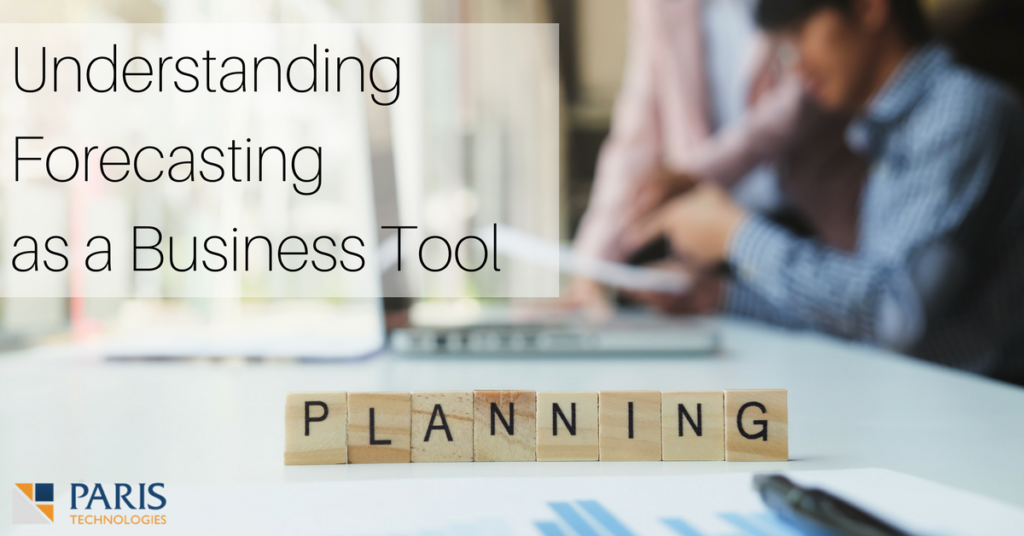
“I have seen the future and it is very much like the present, only longer.”
‒ Kehlog Albran, The Profit
An organization must be able to plan ahead by estimating factors that can have an impact on the business in the coming 90 days, year, etc. This is the art of forecasting – telling the future with software, tools, and analytics, instead of a crystal ball. Forecasting is an integral component of business planning. You need to be able to estimate things like sales volumes, overall company expenses, profit margins, etc. to give your organization an idea of its path forward – not to mention, providing inspiration to reach and exceed expectations.
Forecasting typically relies on using historical data and other key “inputs” to be able to determine future trends. This really is Business Intelligence in action. When you have an accurate picture of the past (BI), you can use a forecast to predict outcomes for the future. It doesn’t matter the size of your company; big or small, your going-forward business plan will be created from this forecast.
Striving for Forecast Illumination
Forecasting is of strategic (and critical) importance, as it is the means to estimate income that can be generated in the future. It will also be used to determine expenses going forward. This projected revenue is essential for predicting the amount required to cover the organizational expenses. A financial forecast is the backbone of business success, and technology can help automate the forecast to allow for integration with operational strategy. This is critical for managing working capital and cash flow.
Forecasts will usually be revised if and when new data gives further insights into revenue and expenses. It is harder for a newer businesses to make financial forecasts—the same might be said of small business, that do not have a healthy corpus of data (or access to same); however, it is a vital element for any business to forecast, in order to become “future fit.“
If a business is seasonal, the process will yield dividends if studiously employed. A rolling forecast as opposed to a year-over-year look can help companies take a more productive approach to their review.
“Prophesy is a good line of business, but it is full of risks.”
‒ Mark Twain in Following the Equator
Forecasting Methods
Traditionally there are two techniques that financial forecasters use to arrive at their conclusions. They are qualitative and quantitative methods.
In brief, the qualitative method relies quite heavily on non-data-driven judgment, involving:
- Little or no historical data
- Limited scope objectives
- Relying on the judgment of experts
- Opinions of key executive-level personnel
With so much data now available to us, quantitative techniques are now more common than ever; such techniques involve:
- Extensive use of historical data across all categories
- Analyzing the data to arrive at forecasting estimates
- Using Proforma financial statements from the previous two or three years
- The cause-and-effect method, whereby the forecaster will analyze relationships of certain variables on a series of prospective outcomes
- Time-series forecasting, where data is collected over a long period to discover trends, e.g. simple averaging and exponential smoothing
- Discounting
- Analysis of leading or lagging indicators, where the relationship between the two will estimate performance
- Econometric modeling, where the internal consistency of data sets is tested over time
Looking these over, you might discover that you are already doing some kind (or a lot of!) forecasting, whether in Excel or in a software platform that would provide collaboration and a great deal more scalability.
Analytics to Keep You on Track
Every business wants to optimize resources to generate the highest growth in revenue. A financial forecast gives a business the necessary vision to keep eyes on the future, to attain targeted logical and achievable growth objectives.
A business can successfully plan ahead with a forecast in its hands. Optimally, it can remain resilient and healthy through fluctuations in the market because it has a strong forecast anchoring their efforts.
Perhaps topmost, a business that develops the regular habit of forecasting can, by definition, make changes as market conditions do change, and ‒ as one clever saying goes ‒ “as those conditions change, we must re-forecast to change with them!”

